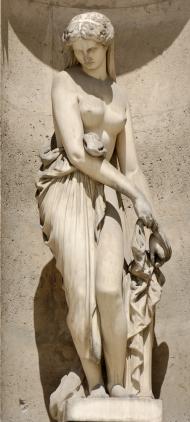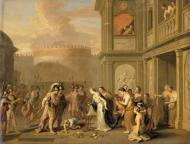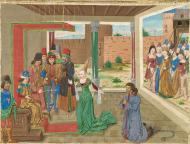من واعد الإسكندر الأكبر؟
بارسينة مؤرخالإسكندر الأكبر من? حتى?.
Campaspe مؤرخالإسكندر الأكبر من? حتى?.
هيفايستيون مؤرخالإسكندر الأكبر من? حتى?.
Cleophis مؤرخالإسكندر الأكبر من? حتى?.
Bagoas مؤرخالإسكندر الأكبر من? حتى?.
الإسكندر الأكبر

الإسكندر الثالث المقدوني، المعروف بأسماء عديدة أخرى أبرزها: الإسكندر الأكبر، والإسكندر الكبير، والإسكندر المقدوني، والإسكندر ذو القرنين (باليونانية: Ἀλέξανδρος ὁ Μέγας؛ نقحرة: ألكساندروس أوميگاس)، هو أحد ملوك مقدونيا الإغريق، ومن أشهر القادة العسكريين والفاتحين عبر التاريخ. وُلد الإسكندر في مدينة پيلا قرابة سنة 356 ق.م، وتتلمذ على يد الفيلسوف والعالم الشهير أرسطو حتى بلغ ربيعه السادس عشر. وبحلول عامه الثلاثين، كان قد أسس إحدى أكبر وأعظم الإمبراطوريات التي عرفها العالم القديم، والتي امتدت من سواحل البحر الأيوني غربًا وصولاً إلى سلسلة جبال الهيمالايا شرقًا. يُعد أحد أنجح القادة العسكريين في مسيرتهم، إذ لم يحصل أن هُزم في أي معركة خاضها على الإطلاق.
خلف الإسكندر والده، فيليپ الثاني المقدوني «الأعور»، على عرش البلاد سنة 336 ق.م، وبعد أن اغتيل الأخير. ورث الإسكندر عن أبيه مملكة متينة الأساس وجيشًا عرمرمًا قويًا ذا جنود مخضرمة. وقد مُنح حق قيادة جيوش بلاد اليونان كلها، فاستغل ذلك ليُحقق أهداف أبيه التوسعيّة، وانطلق في عام 334 ق.م في حملة على بلاد فارس، فتمكن من دحر الفرس وطردهم خارج آسيا الصغرى، ثم شرع في انتزاع ممتلكاتهم الواحدة تلو الأخرى في سلسلة من الحملات العسكرية التي دامت عشر سنوات. تمكن الإسكندر خلالها من كسر الجيش الفارسي وتحطيم القوة العسكرية للإمبراطورية الفارسية الأخمينية في عدّة وقعات حاسمة، أبرزها معركتيّ إسوس وگوگميلا. وتمكن الإسكندر في نهاية المطاف من الإطاحة بالشاه الفارسي دارا الثالث، وفتح كامل أراضي إمبراطوريته،i[›]وعند هذه النقطة، كانت الأراضي الخاضعة له قد امتدت من البحر الأدرياتيكي غربًا إلى نهر السند شرقًا.
كان الإسكندر يسعى للوصول إلى «نهاية العالم والبحر الخارجي الكبير»، فأقدم على غزو الهند سنة 326 ق.م في محاولة لاكتشاف الطريق إلى ذاك البحر، لكنه اضطرّ إلى أن يعود أدراجه بناءً على إلحاح قادة الجند وبسبب تمرّد الجيش. توفي الإسكندر في مدينة بابل سنة 323 ق.م، قبل أن يشرع في مباشرة عدّة حملات عسكرية جديدة خطط لها، وكان أولها فتح شبه الجزيرة العربية. بعد بضعة سنوات من وفاته، نشبت حروب أهلية طاحنة بين أتباعه كان من شأنها أن مزّقت أوصال إمبراطوريته، وولّدت عدّة دول يحكم كل منها «خليفة» وقد عرفت بملوك الطوائف (باليونانية: Διάδοχοι، وباللاتينية: Diadochi)، وكان كل ملك من هؤلاء الملوك مستقل لا يدين بالولاء إلا لنفسه، وكان هؤلاء هم من بقي حيًا من قادة جيش الإسكندر وشاركه حملاته في الماضي.
يشمل إرث الإسكندر التمازج الثقافي الذي خلقته فتوحاته، فقد تمكن من خلط الثقافة الإغريقية الهلينية بالثقافات الشرقية المختلفة للشعوب الخاضعة له، كما أسس أكثر من عشرين مدينة تحمل اسمه في أنحاء مختلفة من إمبراطوريته، أبرزها وأشهرها هي مدينة الإسكندرية في مصر. كما أدّى إنشاء الإسكندر للمستعمرات الإغريقية الكثيرة في طول البلاد وعرضها، إلى خلق حضارة هلينية جديدة استمرت مظاهرها بارزة في تقاليد الإمبراطورية البيزنطية حتى منتصف القرن الخامس عشر. استحال الإسكندر شخصيةً بارزة في الأساطير والقصص والتاريخ اليوناني والعالمي تقريبًا، حتى قام مقام البطل الأسطوري آخيل، وأصبح المقياس الذي يُحدد القادة العسكريون بناءً عليه نجاح أو فشل مسيرتهم، وما زالت المدارس العسكرية حول العالم تُدرّس أساليبه وتكتيكاته الحربيّة حتى الوقت الحالي.ii[›]
اقرأ المزيد...بارسينة

Barsine (Greek: Βαρσίνη; c. 363–309 BC) was the daughter of a Persian father, Artabazus, satrap of Hellespontine Phrygia, and a Greek Rhodian mother, the sister of mercenaries Mentor of Rhodes and Memnon of Rhodes. Barsine became the wife of her uncle Mentor, and after his death married her second uncle, Memnon.
In 334 BC, the year of Alexander's invasion of Asia, she and her children were sent by Memnon to the king Darius III as hostages for his fidelity; and in the ensuing year, when Damascus was betrayed to the Macedonians, she fell into the hands of Alexander, by whom it is said that she became the mother of Heracles.
Twelve years after Alexander's death in 323, Nearchus, who was Barsine's son-in-law, unsuccessfully advocated for Heracles' claim to the throne, who was, then, seventeen, which meant he was born about five years after Barsine and Alexander supposedly met in Damascus, in 333 BC. From a comparison of the accounts of Diodorus and Justin, it appears that he was brought up at Pergamum under his mother's care, and that she shared his fate when in 309 BC Polyperchon was induced by Cassander to murder him. Barsine is sometimes confused with Stateira II, wife of Alexander, who also may have been called "Barsine".
اقرأ المزيد...الإسكندر الأكبر

Campaspe

Campaspe (; Greek: Καμπάσπη, Kampaspē), or Pancaste (; Greek: Παγκάστη, Pankastē; also Pakate), was a supposed mistress of Alexander the Great and a prominent citizen of Larissa in Thessaly. No Campaspe appears in the five major sources for the life of Alexander and the story may be apocryphal. The biographer Robin Lane Fox traces her legend back to the Roman authors Pliny (Natural History), Lucian of Samosata and Aelian's Varia Historia. Aelian surmised that she initiated the young Alexander in love.
According to tradition, she was painted by Apelles, who had the reputation in antiquity for being the greatest of painters. The episode occasioned an apocryphal exchange that was reported in Pliny's Natural History: "Seeing the beauty of the nude portrait, Alexander saw that the artist appreciated Campaspe (and loved her) more than he. And so Alexander kept the portrait, but presented Campaspe to Apelles." Fox describes this bequest as "the most generous gift of any patron and one which would remain a model for patronage and painters on through the Renaissance." Apelles also used Campaspe as a model for his most celebrated painting of Aphrodite "rising out of the sea", the iconic Venus Anadyomene, "wringing her hair, and the falling drops of water formed a transparent silver veil around her form".
اقرأ المزيد...الإسكندر الأكبر

هيفايستيون

Hephaestion (Ancient Greek: Ἡφαιστίων Hēphaistíōn; c. 356 BC – 324 BC), son of Amyntor, was an ancient Macedonian nobleman of probable "Attic or Ionian extraction" and a general in the army of Alexander the Great. He was "by far the dearest of all the king's friends; he had been brought up with Alexander and shared all his secrets." This relationship lasted throughout their lives, and was compared, by others as well as themselves, to that of Achilles and Patroclus.
His military career was distinguished. A member of Alexander the Great's personal bodyguard, he went on to command the Companion cavalry and was entrusted with many other tasks throughout Alexander's ten-year campaign in Asia, including diplomatic missions, the bridging of major rivers, sieges and the foundation of new settlements. Besides being a soldier, engineer and diplomat, he corresponded with the philosophers Aristotle and Xenocrates and actively supported Alexander in his attempts to integrate the Greeks and Persians. Alexander formally made him his second-in-command when he appointed him Chiliarch of the empire. Alexander also made him part of the royal family when he gave him as his bride Drypetis, sister to his own second wife Stateira, both daughters of Darius III of Persia.
When Hephaestion died suddenly at Ecbatana around age thirty-two, Alexander was overwhelmed with grief. He petitioned the oracle at Siwa to grant Hephaestion divine status and thus Hephaestion was honoured as a Divine Hero. Hephaestion was cremated and his ashes taken to Babylon. At the time of his own death a mere eight months later, Alexander was still planning lasting monuments to Hephaestion's memory.
اقرأ المزيد...الإسكندر الأكبر

Cleophis

Cleophis (Sanskrit: Kripa ) was an Assacani queen and key figure in the war between the Assacani people and Alexander the Great. Cleophis was the mother of Assacanus, the Assacanis' war-leader at the time of Alexander's invasion in 326 BCE. After her son's death in battle, Cleophis assumed command and negotiated a settlement that allowed her to retain her status. Later accounts claim Cleophis had a son by Alexander, a notion dismissed by historians.
The Assacani (called Ashvakas in Sanskrit, from the word Ashva, meaning "horse") were an independent people who lived in parts of the Swat and Buner valleys in ancient Gandhara. These highlanders were rebellious, fiercely independent clans who resisted subjugation.
اقرأ المزيد...الإسكندر الأكبر

Bagoas
